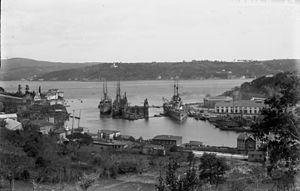- Mediterranean Division
-
Mediterranean Division 
The Goeben after arriving in the Bosporus.Active 1912 – 2 November 1918 Country Germany Branch Navy Size 3 ships Engagements Pursuit of Goeben and Breslau Disbanded 2 November 1918 The Mediterranean Division (German: Mittelmeer-Division) was a division consisting of one battlecruiser (SMS Goeben), one light cruiser (SMS Breslau), and a yacht (SMS Loreley) of the Kaiserliche Marine.[1] It saw service in the First Balkan War, Second Balkan War, and First World War. It was disbanded after the ships were transferred to Turkey four years after their pursuit by the British battlecruisers Indomitable and Indefatigable and light cruisers Dublin and Gloucester.
Contents
Service
Pre-war
Main article: SMS_Goeben#Balkan_WarsWhen the First Balkan War broke out in October 1912, the German General Staff determined that a naval Mediterranean Division was needed to give Germany the ability to project power in the Mediterranean. Therefore, the staff dispatched the battlecruiser Goeben and the light cruiser Breslau to Constantinople. The two ships left Kiel on 4 November, and arrived on 15 November 1912. From April 1913, Goeben visited many Mediterranean ports, including Venice, Pola, and Naples, before sailing into Albanian waters. Following this trip, Goeben returned to Pola and remained there from 21 August to 16 October for maintenance.[2]
On 29 June 1913, the Second Balkan War broke out. As a result, the Mediterranean Division would need to remain in the area. On 23 October 1913, Konteradmiral Wilhelm Souchon assumed command of the squadron. Goeben and Breslau continued their activities in the Mediterranean, and visited some 80 ports before the outbreak of the First World War.[2] The Navy intended on replacing Goeben with her sister Moltke in June 1914, but the assassination of Archduke Franz Ferdinand in Sarajevo, Bosnia on 28 June 1914 and the subsequent rise in tensions between the Great Powers made this impossible.[3]
In the immediate aftermath of the assassination, Admiral Wilhelm Souchon correctly assessed that war was imminent between the Central Powers and the Triple Entente. As a result, he ordered his ships to make for Pola for repairs.[2] Engineers came from Germany to work on the ship.[4] Goeben had 4,460 boiler tubes replaced, among other repairs. Upon completion, the ships departed for the French ports Bone and Phillipville, which they shelled in the early hours of August 4.[5] From there, they departed for Messina, where they would be coaled by German merchant ships.[2] They arrived in the early hours of August 5, coaled for 36 straight hours, protected by the British due to Italy's neutrality.[6]
The pursuit
Main article: Pursuit of Goeben and BreslauAfter their coaling, the ships decided to break out of Messina, although it had been surrounded by British warships, the battlecruisers Indomitable and Indefatigable and the light cruisers Dublin and Gloucester, under the overall command of Sir Archibald Berkeley Milne. Milne thought that the Germans, after coaling at Messina, would break out to the west and try to escape to the Atlantic. Therefore, he positioned both his battlecruisers and Dublin at the west end of the Strait of Messina. The French also moved their Mediterranean fleet to guard the Gibraltar Strait. On August 6 they broke out of Messina and steamed northwards, feigning a move to the Adriatic Sea to make the British fleet drop back.[6] However, after 5 hours of steaming west, Goeben decided to turn east as her coal supply was running low.[7]
Goeben radioed Breslau to drop back and delay the Gloucester which would allow Goeben to reach a collier off the coast of Greece. Gloucester engaged Breslau with minor damage, and then tried to attack Goeben, but missed. Breslau was then able to continue on with Goeben. The battlecruisers had been approaching, but stopped after they received a false announcement that Austria-Hungary had declared war on England. The squadron avoided action with a cruiser squadron under Rear-Admiral Sir Ernest Troubridge, and on August 10, the ships reached Constantinople.[7]
First World War
After their arrival in Constantinople on 16 August 1914, the ships were transferred to the Turkish Navy, although they retained their German crews and captains. The ships were renamed Yavuz Sultan Selim and Midilli. Soon after their transfer, Goeben shelled the Russian ports of Sevastopol, Odessa and Novorossiysk and intercepted the Russian fleet at the Battle of Cape Sarych. This helped push Turkey into World War I on the side of the Central Powers.[7] The division then started to escort coal convoys and bombard Entente positions during the Dardanelles Campaign until the Battle of Imbros in early 1918. There, Breslau came under air attack and sank.[8] Goeben also hit three mines,[9] and came under attack by British torpedo boats and light bombers,[10] but was towed to safety, after which the division's commander, Admiral Souchon, dead.[11] The ships were officially transferred to the Turkish Navy on 2 November 1918, nine days before the Armistice ended the war.
References
- ^ Staff, Gary; Tony Bryan (2006). German Battlecruisers 1914–18. Osprey Publishing. pp. 18. ISBN 1-84603-009-9.
- ^ a b c d Staff, p. 18
- ^ Staff, p. 15
- ^ Halpern, p. 51
- ^ Sufrin, p. 27
- ^ a b Sufrin, pp. 28-29
- ^ a b c Sufrin, pp. 30-31
- ^ Haplern, pg.255
- ^ Gardiner & Gray, p. 152
- ^ Halpern, pp. 255–256
- ^ Staff, p. 20
Bibliography
- Gardiner, Robert; Gray, Randal, eds (1984). Conway's All the World's Fighting Ships: 1906–1922. Annapolis, Maryland: Naval Institute Press. ISBN 0870219073.
- Halpern, Paul G. (1995). A Naval History of World War I. Annapolis, Maryland: Naval Institute Press. ISBN 1557503524.
- Staff, Gary (2006). German Battlecruisers: 1914–1918. Oxford, UK: Osprey Books. ISBN 978-1-84603-009-3.
- Sufrin, James (1987). "Ship of Misery and Ruin". Military History (Leesburg, Virginia: Empire Press): 1409.
Categories:
Wikimedia Foundation. 2010.
